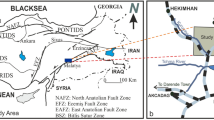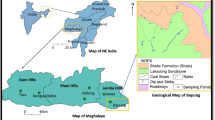Abstract
Based on the GC-MS analytical data of aromatic fractions of over forty highly mature coal-bearing source rock samples collected from the Upper Triassic Xujiahe Formation in the northern Sichuan Basin, the thermal evolution of aromatic hydrocarbons during late-mature to over-mature stage (R o=1.13%–2.85%) was characterized, and aromatic indicators suitable for recognizing the organic source and sedimentary environment of high maturity source rocks were discussed. The results indicated that the concentrations of low carbon-cycle naphthalene as well phenanthrene series reduce gradually with increasing R o at the highly mature levels. However, some high-cyclic components such as chrysene, benzofluoranthene, and benzo[e]pyrene are relatively enriched, in companying an enhancement of parent aromatic compounds. The variations are attributed to thermal cracking and polymerization reactions due to continuous dehydrogenation under enhanced burial temperature. As thermal maturity rises, MPI1 (Methylphenanthrene Index) values display a two-modal varying trend, namely, increasing when R o is below 1.80% and decreasing above 1.8% R o. The relationships between R o and MPI1 are R o=0.98MPI1+0.37 for R o<1.80% and R o=−0.90MPI1+3.02 at R o>1.8%, being different from the previous research. The amount of dibenzofurans declines sharply at R o higher than 1.1%, leading to a significant change of relative composition among dibenzothiophenes, dibenzofurans and fluorenes (referred as three-fluorenes series composition). Thus, this parameter appears to be unsuitable for identifying the sedimentary environment of the highly matured source rocks. 4-/1-MDBT (methyldibenzothiophene) ratio could be served as an effective indicator for organic facies, and can distinguish coals from mudstones at over-maturity in this case. The ratios of 2,6-/2,10-DMP (dimethylphenanthrene) and 1,7-/1,9-DMP and the relative abundance of triaromatic steroids in these highly mature rocks could be considered as biological source parameters for relative input of terrigenous versus aquatic organic matter.
Similar content being viewed by others
References
Alexander R, Kagi R I, Rowland S J, et al. 1985. The effects of thermal maturity on distributions of dimethylnaphthalenes and trimethylnaphthalenes in some ancient sediments and petroleum. Geochim Cosmochim Acta, 49: 385–395
Bao J P, Wang T G, Chen F J. 1996. Relative abundance of alkyl dibenzothiophene in the source rocks and their geochemical significances (in Chinese). J Univ Petrol, 20: 19–23
Boreham C J, Crick I H, Powell T G. 1988. Alternative calibration of the methylphenanthrene index against vitrinite reflectance: Application to maturity measurements on oil and sediments. Org Geochem, 12: 289–294
Budzinski H, Garrigues P, Connan J, et al. 1995. Alkylated phenanthrene distributions as maturity and origin indictors in crude oils and rock extracts. Geochim Cosmochim Acta, 59: 2043–2056
Cassani F, Gallango O, Talukdar S, et al. 1988. Methylphenanthrene maturity index of marine source rocks extracts and crude oils from the Maracaibo Basin. Org Geochem, 13: 73–80
Cheng K M, Wang T G, Zhong N N, et al. 1995. Geochemistry of Hydrocarbons Source Rocks (in Chinese). Beijing: Science Press. 203–233
George S C. 1992. Effect of igneous intrusion on the organic geochemistry of a siltstone and an oil shale horizon in the Midland Valley of Scotland. Org Geochem, 18: 705–723
Hu J Y, Huang D F. 1991. Bases of Non-marine Petroleum Geology in China (in Chinese). Beijing: Petroleum Industry Press, 189
Huang H, Pearson M J. 1999. Source rock palaeoenvironments and controls on the distribution of dibenzothiophenes in lacustrine crude oils, Bohai Bay Basin, Eastern China. Org Geochem, 30: 1455–1470
Hughes W B. 1984. Use of thiophenic organosulfur compounds in characterizing crude oils derived from carbonate versus siliciclastic sources. In: Palacas J G, ed. Petroleum Geochemistry and Source Rock Potential of Carbonate Rocks. Tulsa: AAPG Studies Geol. 18: 181–196
Kvalheim O M, Christy A A, Telnaes N, et al. 1987. Maturity determination of organic matter in coals using the methylphenanthrene distribution. Geochim Cosmochim Acta, 51: 1883–1888
Li S M, Pang X Q, Jin Z, et al. 2010. Molecular and isotopic evidence for mixed-source oils in subtle petroleum traps of the Dongying South Slope, Bohai Bay Basin. Mar Pet Geol, 27: 1411–1423
Liang D G, Guo T L, Chen J P, et al. 2009. Some progresses on studies of hydrocarbon generation and accumulation in marine sedimentary regions, Southern China (Part 2): Geochemical characteristics of four suits of regional marine source rocks, South China (in Chinese). Mar Orig Petrol Geol, 14: 1–15
Lin R Z, Wang P R. 1991. PAH in fossils and their geochemical significance. J Southeast Asian Earth Sci, 5: 257–262
Milner C W D, Rogers M A, Evans C R. 1977. Petroleum transformations in reservoirs. J Geochem Explor, 7: 101–153
Pan C L, Liu S G, Ma Y S, et al. 2011. Analysis on main controlling factors of gas accumulation in Xujiahe Formation of northeast Sichuan Basin (in Chinese). Fault-Block Oil Gas Field, 18: 418–423
Peters K E, Walters C C, Moldowan J M. 2005. The Biomarker Guide: Biomarkers and Isotopes in Petroleum Systems and Earth History. Cambridge: Cambridge University Press. 586–587
Price L C. 1993. Thermal stability of hydrocarbons in nature: limits, evidence, characteristics, and possible controls. Geochim Cosmochim Acta, 57: 3261–3280
Radke M, Welte D H, Willsch H. 1982. Geochemical study on a well in the Western Canada Basin: relation of the aromatic distribution pattern to maturity of organic matter. Geochim Cosmochim Acta, 46: 1–10
Radke M, Walte D H. 1983. The methylphenanthrene index (MPI): A maturity parameter based on aromatic hydrocarbons. In: Bjoroy M, ed. Advances in Organic Geochemistry 1981. Hoboken: John Wiley and Sons Limited. 504–512
Radke M, Welte D H, Willsch H. 1986. Maturity parameters based on aromatic hydrocarbons: Influence of the organic matter type. Org Geochem, 10: 51–63
Radke M. 1988. Application of aromatic compounds as maturity indicators in source rocks and crude oils. Mar Pet Geol, 5: 224–236
Radke M, Vriend S P, Ramanampisoa L R. 2000. Alkyldibenzofurans in terrestrial rocks: Influence of organic facies and maturation. Geochim Cosmochim Acta, 64: 275–286
Shen Z M, Wei J H, Zhu H Q, et al. 2009. Comparative research on maturity feature and maturity indicator of coal source rock from west Sichuan Basin Depression (in Chinese). J Mineral Petrol, 29: 83–88
Szczerba M, Rospondek M J. 2010. Controls on distributions of methyl-phenanthrenes in sedimentary rock extracts: Critical evaluation of existing geochemical data from molecular modeling. Org Geochem, 41: 1297–1311
Zhang M, Huang G H, Li H B, et al. 2012. Molecular geochemical characteristics of gas source rocks form the Upper Triassic Xujiahe Formation indicate transgression events in the Sichuan Basin. Sci China Earth Sci, 55: 1260–1268
Zhu Y M. 1996. Geochemical characteristics of aromatic hydrocarbon from oils in Tarim Basin (in Chinese). Geochimica, 25: 10–17
Zhu Y M, Gu S X, Li Y, et al. 2012a. Biological organic source and depositional environment of over-mature source rocks of Longtan Formation in Sichuan basin (in Chinese). Geochemica, 44: 35–44
Zhu Y M, Li Y, Zhou J, et al. 2012b. Geochemical characteristics of Tertiary coal-bearing source rocks in Xihu depression, East China Sea basin. Mar Pet Geol, 38: 154–165
Author information
Authors and Affiliations
Corresponding authors
Rights and permissions
About this article
Cite this article
Li, Y., Zhu, Y., Hao, F. et al. Thermal evolution and applications of aromatic hydrocarbons in highly mature coal-bearing source rocks of the Upper Triassic Xujiahe Formation in the northern Sichuan Basin. Sci. China Earth Sci. 58, 1960–1969 (2015). https://doi.org/10.1007/s11430-015-5084-8
Received:
Accepted:
Published:
Issue Date:
DOI: https://doi.org/10.1007/s11430-015-5084-8




